Digital Twin Market Size
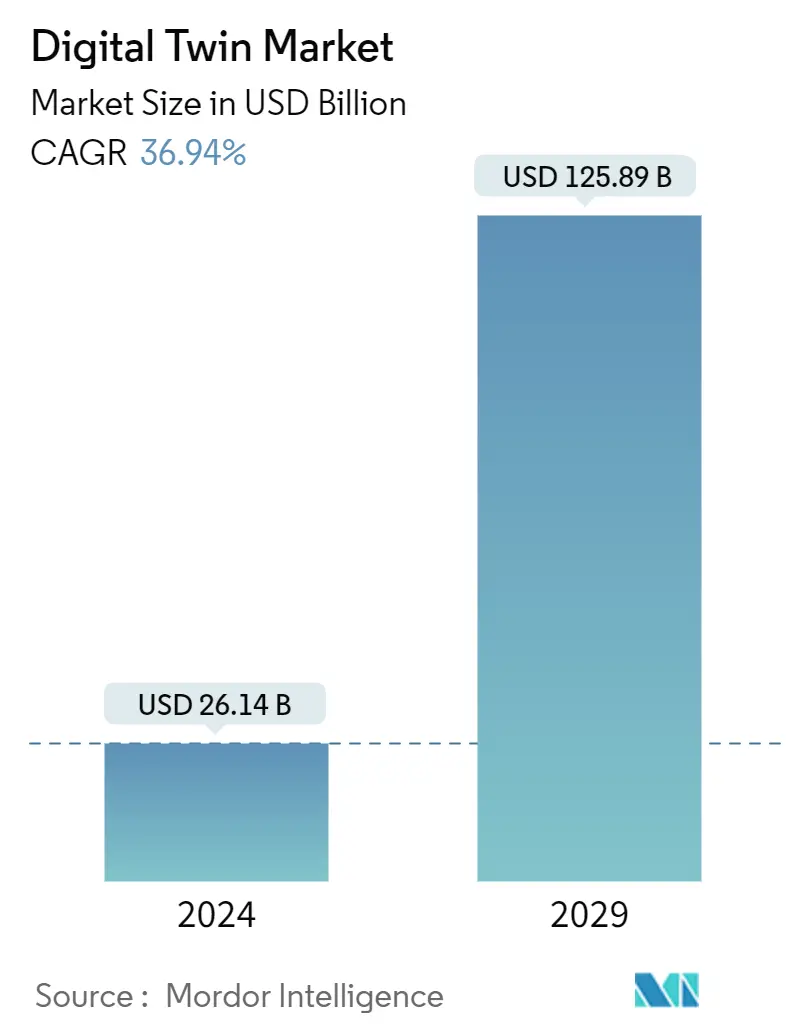
| Study Period | 2019 - 2029 |
| Market Size (2024) | USD 26.14 Billion |
| Market Size (2029) | USD 125.89 Billion |
| CAGR (2024 - 2029) | 36.94 % |
| Fastest Growing Market | Asia Pacific |
| Largest Market | North America |
Major Players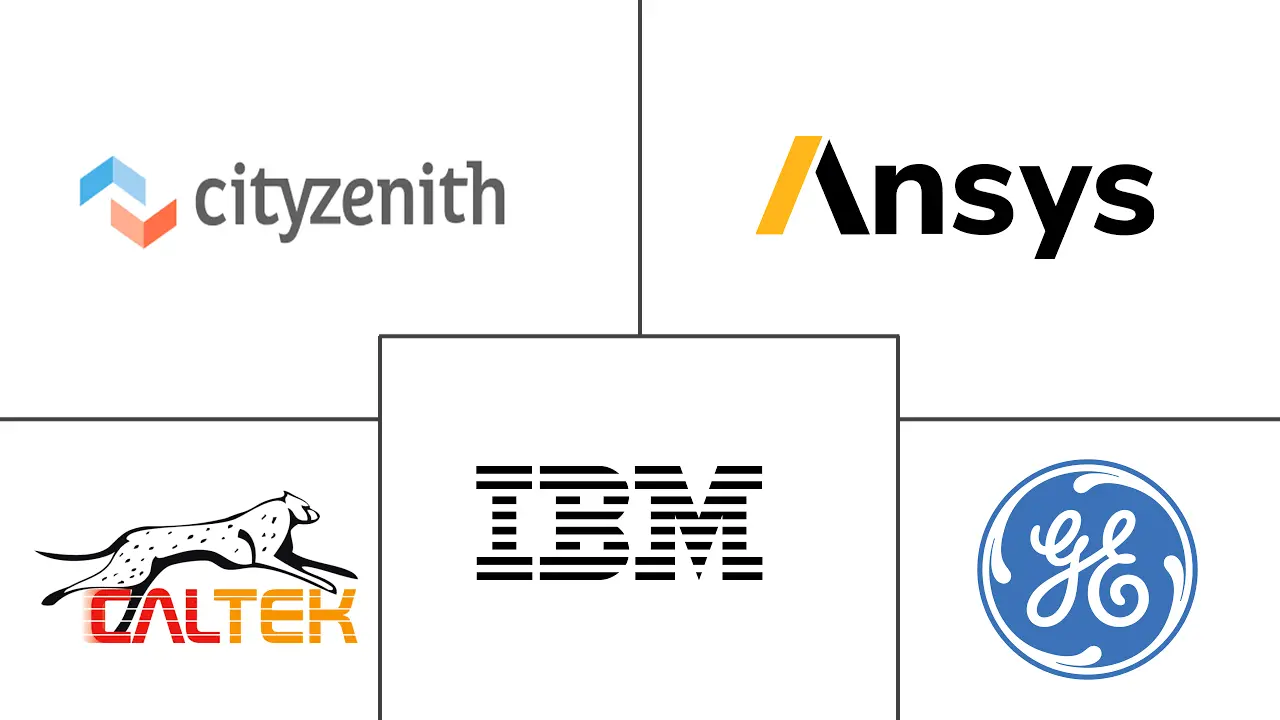
*Disclaimer: Major Players sorted in no particular order |
Need a report that reflects how COVID-19 has impacted this market and its growth?
Digital Twin Market Analysis
The Digital Twin Market size is estimated at USD 26.14 billion in 2024, and is expected to reach USD 125.89 billion by 2029, growing at a CAGR of 36.94% during the forecast period (2024-2029).
To simplify the manufacturing process and offer a variety of innovative approaches for cutting costs, optimizing maintenance, monitoring assets, reducing downtime, and creating new linked products, technological twin solutions are expected to be transformed. The digital twin model, although familiar, has been entering manufacturing and other industries fast. Technologies such as IoT and cloud-based platforms have been significant drivers for the increased adoption of these solutions.
- Digital twins incorporate big data, the Internet of Things (IoT), machine learning (ML), and artificial intelligence (AI) in Industry 4.0. They are predominantly used in the Industrial Internet of Things (IIoT), engineering, and manufacturing business space. In a world where the Internet of Things is used widely, digital twins have become more efficient and accessible to businesses. The manufacturers have estimated that around 40 % of the Internet of Things players are expected to integrate simulation platforms, systems, and capabilities for developing digital twins.
- The way companies deliver preventive maintenance for products and equipment in the field is also undergoing a transformation timed to be driven by data twins. To identify and fix malfunctions before they occur and set up service and maintenance plans to satisfy individual customer requirements, sensors incorporated in these machines have been transmitting performance information in real-time into a Digital Twin.
- To avoid these difficulties with 3D printing, the whole production process has been simulated using twinning technology. This technology can tell if there will be distortions and where they may occur in a 3D model, so it is possible to correct them. This can result in new models that are fully optimized to compensate for the discrepancies and obtain the best possible printing results.
- The market's growth is expected to be significantly hampered by the presence of traditional systems used in underdeveloped countries. Most of these legacy systems had already been developed but were primarily designed and built to function without connectivity. They cannot incorporate advanced sensor technology that offers real-time data, limiting the adoption of advanced technologies.
- The adoption rate of Industry 4.0 technologies, e.g., digital twins, is accelerating due to the COVID-19 pandemic and contributing to market growth. Governments worldwide have also explored the possibility of deploying a different smart city solution to improve urban resilience. For instance, the Singapore government recognized the importance of accelerating digitalization across industries. These factors are expected to drive the demand for these solutions.
Digital Twin Market Trends
Growth in IoT and Cloud-based Platforms to Drive the Market
- The Digital Twin solutions are expected to transform production processes and offer new ways to lower costs, optimize maintenance and asset management, reduce downtime, and create new connected products. Even though it's not new, digital twins are rapidly starting to enter the production and industrial sectors. Emerging technologies like the Internet of Things and cloud-based platforms are significant drivers for the rapid adoption of these solutions.
- All the leading cloud providers have recently implemented a significant digital twin capability. In construction and building management, Microsoft has released a digital twin ontology. In logistics and manufacturing, Google has launched a digital twin service. To simplify the digital twins of factories, industry equipment, and fleet vehicles, Amazon Web Services has launched Internet of Things TwinMaker and FleetWise. In addition, Nvidia has launched a metaverse for engineers on its partner network as an ad hoc subscription service.
- In addition, it is anticipated that the interaction of digital and biological worlds will change due to the IoT and digital twins as the Internet of Things is increasingly connecting and accessing intelligence in a physical world through digital twins almost identical to their physical counterparts. Additionally, the adoption of the Internet of Things is being stimulated by new applications, business models, and declining costs for equipment, resulting in a growing number of interconnected devices and endpoints worldwide. The massive IoT technologies NB-IoT and Cat-M1 continue to be rolled out globally.
- IoT is used everywhere, from industrial applications to emergency services, public transportation, public safety, city lighting, and smart city applications. Municipalities are moving to wireless communications offered by IoT due to low cost, greater efficiency, and resource reduction.
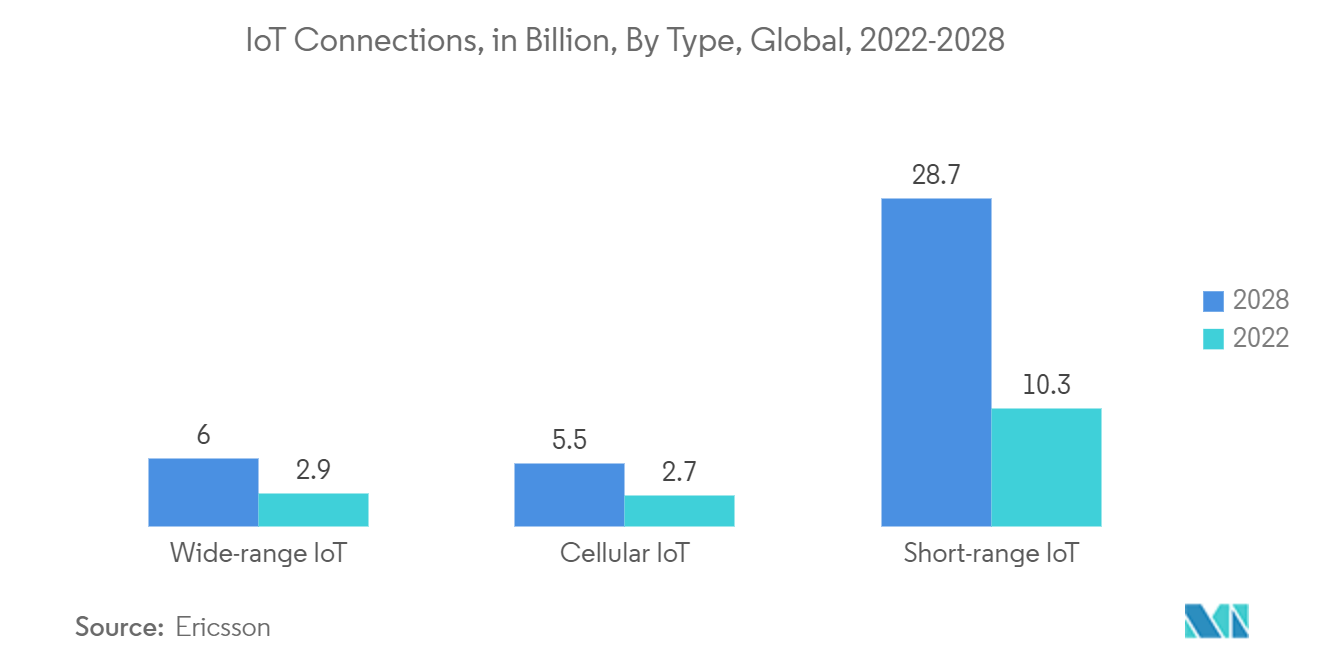
North America Holds Major Market Share
- Modern manufacturing facilities in the United States rely on new technologies and innovations to produce superior-quality products at low costs. The US industry plans to integrate digital twins into their processes to simplify and leverage more advanced insight, thanks to the early adoption of increasingly popular technologies such as IoT, Big Data, DevOps, or Mobility.
- The construction sector continues to be a major 2D industry relying on technology innovation, even though the manufacturing sector has begun adopting digital twin technologies. With 3D visual digital twin technology, off-site experts can access on-site views into the nitty-gritty of projects taking off where Google Street View ends.
- The Canadian manufacturing, construction, and automotive industries have adopted significant digital twin technologies. To measure the performance of such Physical Assets and identify where improvements could be made to achieve more favorable results, organizations within those sectors are using Digital Twin Technology.
- For instance, in November 2022, the project, AI-enabled Digital Twins for Automation of Regulatory Processes in the Built Environment, was carried out in collaboration with four Canadian institutions nationwide by AECO Innovation Lab. The project supports innovation and Digital Transformation of the Architecture, Engineering, and Construction industries and related sectors within the public sector. This project examines how new ideas, digital tools, and technology can be used to improve and transform the approval process. In addition, it examines how Canada's regulators could use BIM and Digital twins to understand their decisions better.
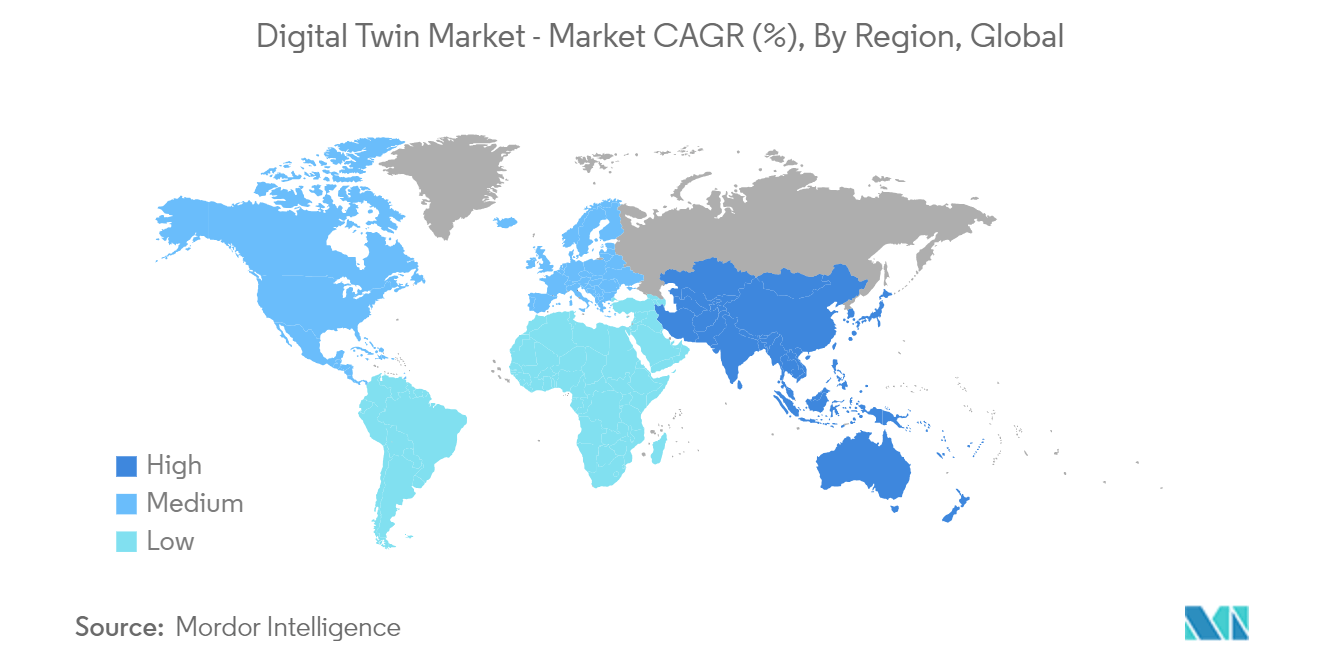
Digital Twin Industry Overview
The digital twin market is fragmented with major players like ANSYS Inc., Cal-Tek SRL, Cityzenith Inc., General Electric Company, and IBM Corporation. Players in the market are adopting strategies such as partnerships and acquisitions to enhance their service offerings and gain sustainable competitive advantage.
In June 2023, Mevea announced delivering digital twins, simulation software, and training simulators to Siemens. Siemens integrates these solutions within its open and modular SIMOCRANE Remote Control Systems (RCOS) to remotely control all relevant crane types like STS, Cantilever ARMG, end loading ASC, and RTG. The digital twins are used in crane automation, software testing & development, and operator training.
In March 2023, ANSYS Inc. and L&T Technology Services Limited signed an MOU to establish the LTTS-Ansys Center of Excellence (CoE) for Digital Twin. The center will support LTTS in demonstrating industry use cases, developing future-facing solutions, and enabling its customers to optimize design, manufacturing, and supply chain processes. Ansys' Twin Builder solution will further allow LTTS to expand its market share in digital twin areas.
Digital Twin Market Leaders
ANSYS Inc.
Cal-Tek SRL
Cityzenith Inc.
General Electric Company
IBM Corporation
*Disclaimer: Major Players sorted in no particular order
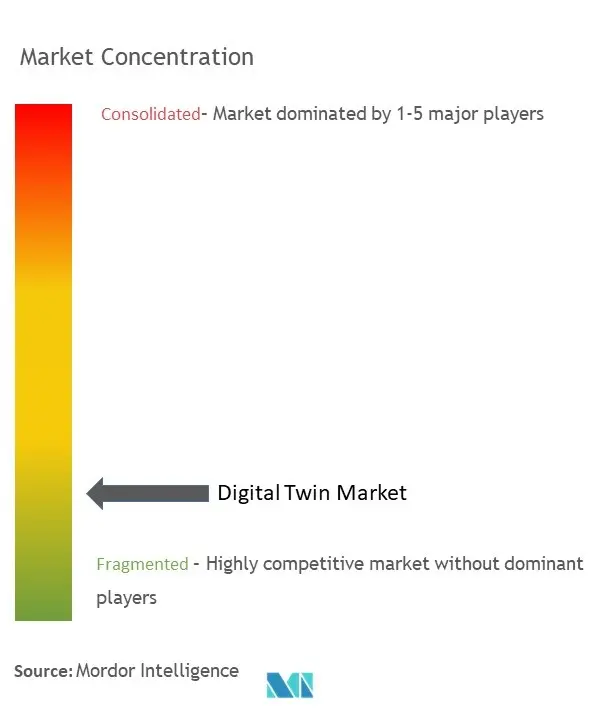
Digital Twin Market News
- February 2023: Prevu3D, a 3D digital twin technology developer, led a USD 10 million in Series A fundraising round closed by Cycle Capital, a growth-stage climate tech venture capital firm. The deployment of Prevu3D's 3D digital twin platform in industrial contexts could be expanded and accelerated with additional funding.
- February 2023: To advance AI-driven digital twin generation in manufacturing, German startup RIIICO raised USD 1.5 million in a pre-seed investment round led by Earlybird Venture Capital and US-based investors. RIIICO, which gives manufacturing organizations the ability to create digital layouts at the level of the virtual factory floor, would enable the business to extract data directly from the shop floor and convert them into a factory digital twin using deep learning on 3D scans to give virtual representations of a product, process, service, or capability that could be used to visualize, track, and represent a real factory in three dimensions.
Electrical Digital Twin Market Report - Table of Contents
1. INTRODUCTION
1.1 Study Assumptions and Market Definition
1.2 Scope of the Study
2. RESEARCH METHODOLOGY
3. EXECUTIVE SUMMARY
4. MARKET INSIGHTS
4.1 Market Overview
4.2 Industry Attractiveness - Porter's Five Forces Analysis
4.2.1 Bargaining Power of Suppliers
4.2.2 Bargaining Power of Consumers
4.2.3 Threat of New Entrants
4.2.4 Threat of Substitutes
4.2.5 Intensity of Competitive Rivalry
4.3 Industry Value Chain Analysis
4.4 Assessment of the Impact of COVID-19 on the Industry
5. MARKET DYNAMICS
5.1 Market Drivers
5.1.1 Growth in IoT and Cloud-based Platforms
5.1.2 Surge in Adoption of 3D Printing Technology in the Manufacturing Industry
5.1.3 Objective to Reduce Project Cost
5.2 Market Challenges
5.2.1 Inadequate Infrastructure in Under-developed Countries and Data Security-related Concerns
6. MARKET SEGMENTATION
6.1 By Application
6.1.1 Manufacturing
6.1.2 Energy and Power
6.1.3 Aerospace
6.1.4 Oil and Gas
6.1.5 Automobile
6.1.6 Others Applications
6.2 By Geography
6.2.1 North America
6.2.1.1 United States
6.2.1.2 Canada
6.2.2 Europe
6.2.2.1 United Kingdom
6.2.2.2 Germany
6.2.2.3 France
6.2.2.4 Rest of Europe
6.2.3 Asia Pacific
6.2.3.1 China
6.2.3.2 Japan
6.2.3.3 India
6.2.3.4 Rest of Asia Pacific
6.2.4 Rest of the World
7. COMPETITIVE LANDSCAPE
7.1 Company Profiles*
7.1.1 ANSYS Inc.
7.1.2 Cal-Tek SRL
7.1.3 Cityzenith Inc.
7.1.4 General Electric Company
7.1.5 IBM Corporation
7.1.6 Lanner Group Limited (Royal Haskoning DHV)
7.1.7 Mevea Ltd
7.1.8 Microsoft Corporation
7.1.9 Rescale Inc.
7.1.10 SAP SE
8. INVESTMENT ANALYSIS
9. FUTURE OF THE MARKET
Digital Twin Industry Segmentation
A digital twin is a virtual simulation that accurately replicates a physical object. The digital twin market is defined based on the revenues generated from the software and services used in various applications such as oil and gas, manufacturing, automobile, aerospace, and other end users across the globe. The analysis is based on the market insights captured through secondary research and the primaries. The market also covers the major factors impacting the market's growth in terms of drivers and restraints.
The digital Twin Market is segmented by application (manufacturing, energy and power, aerospace, oil and gas, automobile) and geography (North America (United States, Canada), Europe (United Kingdom, Germany, France, and the rest of Europe), Asia Pacific (China, Japan, India, and the rest of Asia Pacific), and the Rest of the World). The market sizes and forecasts are provided in terms of value in USD for all the above segments.
| By Application | |
| Manufacturing | |
| Energy and Power | |
| Aerospace | |
| Oil and Gas | |
| Automobile | |
| Others Applications |
| By Geography | ||||||
| ||||||
| ||||||
| ||||||
| Rest of the World |
Electrical Digital Twin Market Research FAQs
How big is the Digital Twin Market?
The Digital Twin Market size is expected to reach USD 26.14 billion in 2024 and grow at a CAGR of 36.94% to reach USD 125.89 billion by 2029.
What is the current Digital Twin Market size?
In 2024, the Digital Twin Market size is expected to reach USD 26.14 billion.
Who are the key players in Digital Twin Market?
ANSYS Inc., Cal-Tek SRL, Cityzenith Inc., General Electric Company and IBM Corporation are the major companies operating in the Digital Twin Market.
Which is the fastest growing region in Digital Twin Market?
Asia Pacific is estimated to grow at the highest CAGR over the forecast period (2024-2029).
Which region has the biggest share in Digital Twin Market?
In 2024, the North America accounts for the largest market share in Digital Twin Market.
What years does this Digital Twin Market cover, and what was the market size in 2023?
In 2023, the Digital Twin Market size was estimated at USD 16.48 billion. The report covers the Digital Twin Market historical market size for years: 2019, 2020, 2021, 2022 and 2023. The report also forecasts the Digital Twin Market size for years: 2024, 2025, 2026, 2027, 2028 and 2029.
What are the future trends in the Digital Twin Market?
The key future trends in the Digital Twin Market are: a) Integration of AI and machine learning for better predictive analytics b) Increased adoption in Small and Medium Enterprises (SMEs) c) Broader applications in sectors like healthcare and urban planning
Digital Twin Industry Report
The Digital Twins Market is witnessing remarkable growth, fueled by the rising adoption of Internet of Things (IoT) and cloud-based platforms across diverse industries. This innovative technology, which provides a virtual model of a physical object, system, or process, is celebrated for its ability to simulate, monitor, analyze, and optimize operations. The digital twins market size is on an upward trajectory, finding applications in manufacturing, healthcare, automotive, energy, and aerospace sectors. It offers benefits like predictive maintenance, business optimization, and streamlined product development, despite data security and integration challenges. North America leads in adoption due to its technological prowess and digital transformation initiatives, while the Asia Pacific region is rapidly catching up, propelled by smart city and industrial modernization projects. According to Mordor Intelligence™ Industry Reports, the digital twins market share and revenue are growing, with detailed analysis and forecasts available in their free report PDF download. This technology is set to revolutionize industry efficiency and innovation levels.
